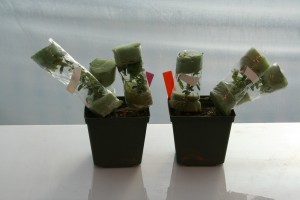Blunt-nosed leafhopper is an important concern for cranberry, not because the insect causes that much feeding damage, but because it can transmit cranberry false blossom disease. False blossom is characterized by a malformation of the flowers. The flower pedicels become erect and there is no production of fruit, with devastating effects for cranberry yield. Blunt-nosed leafhopper nymphs start to occur in the bogs by the end of May, and adults reach their peak numbers in July. Relatively little is known about the way the insects transmit false blossom disease, and at the Cranberry & Blueberry Research Center, we soon hope to change that.
Also, Elvira is evaluating the aromas that healthy and false blossom-infected plants emit. Plant aromas may guide herbivorous insects to a suitable host plant. For other plant – vector insect – disease combinations, it is known that diseased plants emit a different aroma than healthy plants. The diseased plants are actually more attractive to the vector insects, which visit the diseased plants more frequently and in this way increase spread of the disease. It is not unthinkable that false blossom is able to manipulate cranberry aromas in a similar way. Therefore, Elvira studies the aromas of healthy and diseased plants, and she eventually aims to assess the attractiveness of these aromas to the blunt-nosed leafhopper. This information may ultimately help us develop better protection mechanisms against false blossom disease.


